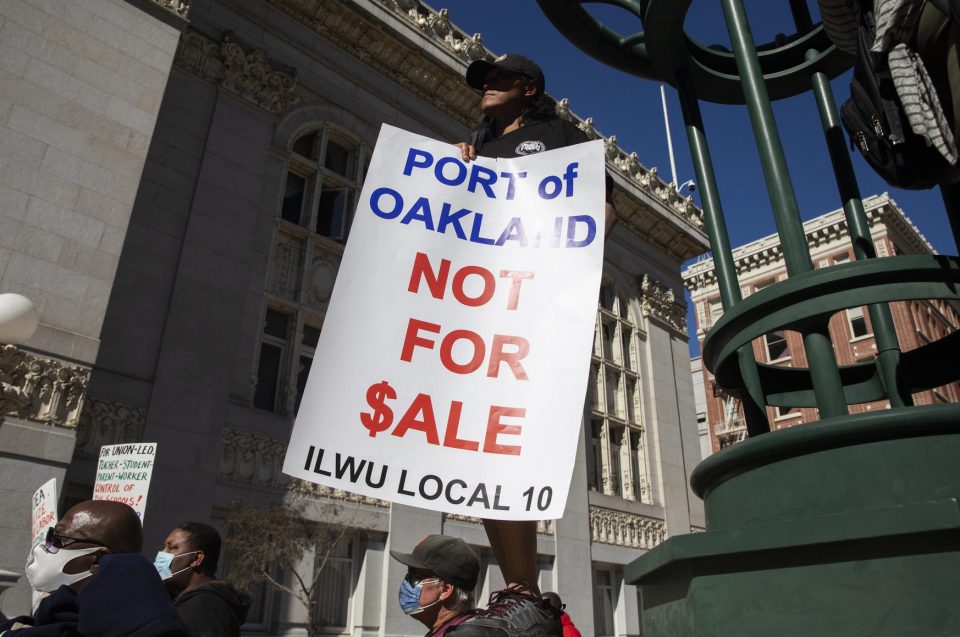The Port of Oakland is the economic engine that drives Northern California, exporting produce from the Central Valley, wine from Napa and Sonoma valleys, and computers and other electronic devices from Silicon Valley. On the import side, it receives cargo from Asia, mainly China. It provides 84,000 jobs in its logistic chain. At the nexus point of this global trade are port longshore workers who load and discharge the ships 24/7 throughout even the deadliest phases of the pandemic.
Despite doing that onerous, and often dangerous work, a worldwide supply chain backup has occurred, in part due to increased demand for imports. The supply chain has never been tasked with moving more cargo than now. Container-handling equipment is in short supply. Workers are pushed to the limit, and higher costs and delays are plaguing the system. Distribution between the docks and inland warehouses is problematic because of the lack of truck drivers and chassis to cover an around-the-clock operation. Added to this conundrum is a critical lack of marine terminal container space to stack containers.
Untangling this logistical knot will be a challenge. And yet Oakland appears ready to stick a new obstacle in the way of keeping the Port of Oakland’s status as a world-class facility that provides good union jobs for Bay Area workers.
Why? Because Oakland A’s billionaire owner John Fisher wants to build a new ballpark in the port on 55 acres of land at Howard Terminal. Fisher’s ballpark and entertainment center scheme includes 1.5 million square feet of office space, 3,000 luxury condos, 400 hotel rooms and 270,000 square feet of retail space.
Port workers are angry and the public should be, too. The port is already facing a shortfall in cargo space, and if Fisher has his way, our supply chain crisis will only be exacerbated.
Some supporters of the stadium plan have characterized the Howard Terminal location for Fisher’s development as a parking lot.
It’s not.
It’s actually a key staging ground for loaded containers and chassis as well as the site where dockworkers are trained on cargo-handling equipment. Mainly it’s used for in-transit cargo. There were 400,000 truck moves at Howard Terminal last year.
Of the 50 major U.S. ports, not one has a sports stadium in the middle of its bustling work zone. Yet, while we’re caught in the twin crises — supply chain backlog and the pandemic — Oakland’s Port Commission and its City Council keep moving closer to approving Fisher’s land grab.
Oakland Mayor Libby Schaaf, an attorney who used to work for the Port Commission’s public affairs office, is one of the main advocates for the billionaire Fisher’s plan. But her arguments don’t hold water. She’s among those disingenuously saying Howard Terminal is only a parking lot. She also argues that it will create good-paying union jobs, but fails to mention that these jobs will only exist while the stadium is being built. Then it reverts to lower paying jobs like parking lot attendants and peanut sellers.
Developer schemes that transfer public property into private hands should always be carefully scrutinized. Yet one wonders if the fox is guarding the chicken coop.
This port stadium plan isn’t Fisher’s first foray into privatization. He has been active in privatizing public education through his KIPP and Rocketship charter school chains. Many Oaklanders see these schemes at the port and schools as a move to further gentrify the city by removing jobs and public schools for poorer Black and brown residents.
Unfortunately, construction trades union bureaucrats are lining up with the billionaire Fisher and appear willing to sacrifice the port’s status as an economic engine in the process.
There’s another path for construction unions. They can create new jobs for their members by renovating the Coliseum in East Oakland where there’s a parcel of 155 acres — three times the size of Howard Terminal — to build a ballpark, homes to mitigate the housing crisis, and plenty of space for offices and retail shops.
In February, the port was idled as longshore workers and teachers rallied in front of City Hall to fight these privatization schemes. The teachers’ union is opposed to the closure of public schools and increase of charter schools.
The union fight against the A’s stadium is being led by the International Longshore and Warehouse Union, Local 10, of which I am president. ILWU has a proud record of organizing solidarity actions for other unions, like the teachers’ Oakland Education Association. At the port, a broad rainbow coalition of workers can defeat Fisher’s scam. It’s high time for all unions to implement labor’s slogan, “An injury to one is an injury to all!”
A stadium can be built almost anywhere, but a port can only be built on tidelands. Once Howard Terminal is lost, it can’t be replaced.
Farless Dailey is president of the International Longshore and Warehouse Union, Local 10.


